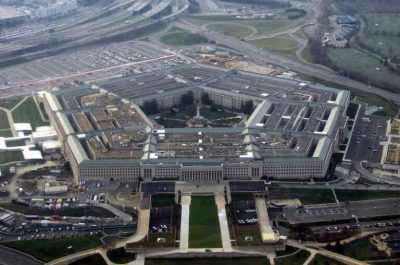The US Unveils Its New Bomber but the Real Future Is Next Door
The future of manufacturing lies in building infrastructure that runs on clean energy and transport, not weapons development.

All Global Research articles can be read in 51 languages by activating the Translate Website button below the author’s name.
To receive Global Research’s Daily Newsletter (selected articles), click here.
Follow us on Instagram and Twitter and subscribe to our Telegram Channel. Feel free to repost and share widely Global Research articles.
***
In the desert beyond the San Gabriel Mountains north of LA sits a vast air base with the unassuming name of Plant 42. It houses “black box” weapons projects by three of the Pentagon’s Big Five prime contractors — Lockheed Martin, Boeing, and Northrop Grumman. In a Hollywood-esque extravaganza last week, Northrop gave us a peek inside the box. Following soaring orchestral music and flyovers by previous bombers, the prototype B-21 Raider emerged from a haze of blue light and fog.
What followed, for substance amid this display of style, were assurances that while this model looked remarkably similar to the previous one — the B-2 — this model is wholly new and improved.
The same promises, though, were made on that same spot where in 1988, Northrop unveiled the B-2. But, unfortunately, they didn’t pan out. After a litany of problems, like a stealth coating that deteriorated in the rain, and costs that climbed to $2.2 billion a copy for a total of 20 planes, the Department of Defense gave up building B-2s.
The new bomber’s main promised improvement is an “open system architecture” that will allow Northrop to load up the plane with features, as Defense Secretary Lloyd Austin said, “that haven’t even been created yet.” Its assigned missions will include dropping both nuclear and conventional bombs, as well as surveillance and coordinating other aircraft in battle.
This all-things-to-all-people, “we’ll figure this out as we go along” approach should remind us of the most expensive weapons system ever built: the F-35 fighter jet. It’s also supposed to be able to drop nuclear bombs, but it has several problems. Records show decades of discovered defects and soaring costs.
Hyping the China Threat
The timing of the B-21 show may just have something to do with the Pentagon’s release the previous week of its annual report on China. DOD needs to hype the China nuclear threat to justify its $1 trillion-plus expenditure on modernizing its nuclear capabilities (of which the B-21 buy is a major part). Thus the report predicted that by 2035, China’s 400 nuclear warheads would have increased to as many as 1,500.
Having raised this alarm, the Pentagon needed a counter-balancing symbol of US nuclear superiority. As Austin put it at the ceremony, “We are again making it plain to any potential foe: The risks and costs of aggression far outweigh any conceivable gains.” Here was the moment to display its mega-nuclear platform, the B-21, ready or not. (After this first glimpse, the plane goes back in the box until well into 2023.)
But as William Hartung pointed out after the China report was released, even if China’s nuclear stockpile aspirations come true, they will be no match for the US 5400 warheads, more than 1,600 mounted on submarines, bombers, and long-range missiles.
The real threat to humanity comes from the increasing speeds with which these weapons can be delivered, increasingly removed from human decision-making and immediate consequences to those delivering them. These are two of the capabilities — for unmanned flight and determined by artificial intelligence — that the Pentagon required be built into the B-21. In addition, the capability to deliver hypersonic missiles is being built into the F-35 and presumably into the B-21, though this remains classified.
The Real Way Forward
The only real solutions to an unprecedentedly dangerous arms race run through a renewed commitment to arms control: for negotiated reductions in stockpiles and framework agreements to control the risks of inadvertent nuclear war from unmanned, AI-driven hypersonic weapons.
Yet, back at Plant 42, sits an unlikely bedfellow to the B-21. It is a Japanese company called Kinkisharyo that is making and repairing electric light rail cars for US cities including Los Angeles, New Jersey, Dallas, and Boston.
Without the steady funding stream that Northrop enjoys, the company has had to cobble together funds from various transit agencies and, when those dry up, to get by on repair work. The critical funding for climate change mitigation in this year’s Inflation Reduction Act should help a lot. But at a total of $37 billion a year, this fund will get less than 4% of what the Pentagon will have to distribute.
While the Pentagon promotes its symbol of nuclear superiority, Kinkisharyo quietly symbolizes where the real future of manufacturing should lie: in building the infrastructure of an economy running on clean energy and transport. The smoke and mirrors next door must not be allowed to disguise that.
*
Note to readers: Please click the share buttons above. Follow us on Instagram and Twitter and subscribe to our Telegram Channel. Feel free to repost and share widely Global Research articles.
Miriam Pemberton, an Associate Fellow at the Institute for Policy Studies, has just published Six Stops on the National Security Tour: Rethinking Warfare Economies. It includes a chapter featuring Plant 42.
Featured image: America’s biggest threat: The Pentagon (US Department of ‘Defense’ photo)

